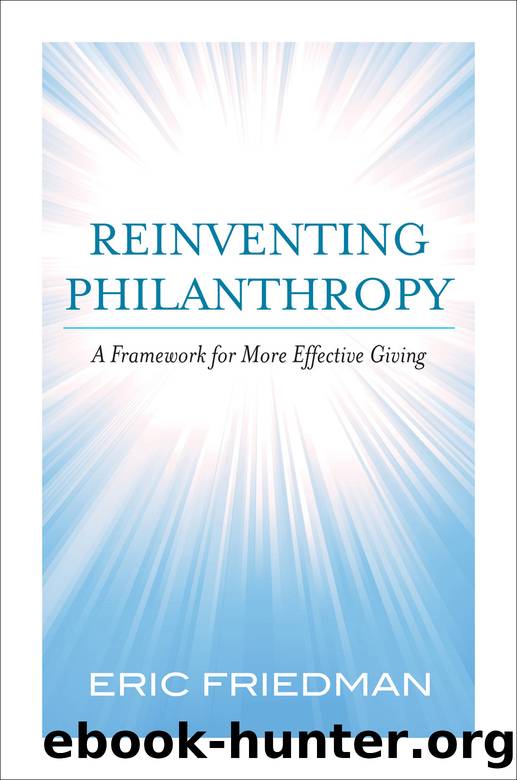Reinventing Philanthropy by Eric Friedman

Author:Eric Friedman
Language: eng
Format: epub
Publisher: Potomac Books Inc.
Published: 2013-03-15T00:00:00+00:00
10
Choosing a Charity
When we consider contributing, we really need to know two things: First, is there good reason to think this idea will work to solve this problem in this setting? Second, will this particular organization implement this idea effectively and efficiently?
âDean Karlan and Jacob Appel1
One of the most revealing discussions I had while writing this book was with the executive director of an international development organization; letâs call him Sam. He originally suggested we meet so he could tell me about his organization and ask for a donation, and I told him that I was writing this book and Iâd be interested in discussing his thoughts on effective philanthropy. The two topics overlapped, as I would need to understand why his organization was more worthy of my giving than other organizations.
Sam had certainly heard others ask a thousand times before why donors should give to his organization. His response to me was probably similar to how he responded to others: he told me what they do and asked if I was interested in supporting them. Unfortunately, this didnât answer the question. He gave me little information to evaluate whether what they do is more worthy than what other organizations do or whether they are good at it. I probed further, but he couldnâtâor at least didnâtâdirectly answer the question.
This would hardly be tolerable in the for-profit sector; most companies are continuously trying to differentiate themselves from their competitors. But it is the norm in the charitable sector. Donors must compare multiple organizations and select from them. In his refusal and inability to compare his organization to others, Sam failed to make his case.
I told Sam that although I had no reason to believe his organization wasnât very good, he didnât seem to have compelling evidence to persuade me that it was. I explained further that his organization was not the only one I knew of with this issue. I then asked him not just how donors should evaluate his organization, but how donors should evaluate any organization. Sam noted (and I agreed) that it would not be good to focus on purely financial metrics like the percentage of revenue dedicated to overhead. Other than that, he seemed stumped.
Sam is far from the only person I talked with about this issue. Nevertheless, I still have not been able to find an answer that is satisfying. I donât think I am trying to do something unreasonable. Iâm not seeking an objective standard to rank every nonprofit with absolute confidenceâthat will never be possible. But having some reasonable principles, standards, or methods for evaluating the quality of a charity doesnât seem like too much to expect.
Donors need a way to sift through the nonsense and evaluate organizations. To address this, Iâve come up with a set of eight principles do-besters can use. This list augments, rather than replaces, the top-down decision factors described earlier. If you believe that a charity follows these principles, then it is a pretty good bet that it would be a good steward of your donation.
Download
This site does not store any files on its server. We only index and link to content provided by other sites. Please contact the content providers to delete copyright contents if any and email us, we'll remove relevant links or contents immediately.
Zero to IPO: Over $1 Trillion of Actionable Advice from the World's Most Successful Entrepreneurs by Frederic Kerrest(4408)
Machine Learning at Scale with H2O by Gregory Keys | David Whiting(4261)
Never by Ken Follett(3885)
Harry Potter and the Goblet Of Fire by J.K. Rowling(3810)
Ogilvy on Advertising by David Ogilvy(3555)
Shadow of Night by Deborah Harkness(3327)
The Man Who Died Twice by Richard Osman(3042)
Book of Life by Deborah Harkness(2895)
Will by Will Smith(2875)
The Tipping Point by Malcolm Gladwell(2873)
0041152001443424520 .pdf by Unknown(2819)
My Brilliant Friend by Elena Ferrante(2793)
How Proust Can Change Your Life by Alain De Botton(2772)
Purple Hibiscus by Chimamanda Ngozi Adichie(2742)
How to Pay Zero Taxes, 2018 by Jeff A. Schnepper(2623)
Hooked: A Dark, Contemporary Romance (Never After Series) by Emily McIntire(2528)
Rationality by Steven Pinker(2330)
Borders by unknow(2281)
Can't Hurt Me: Master Your Mind and Defy the Odds - Clean Edition by David Goggins(2278)
